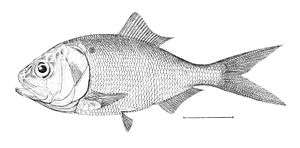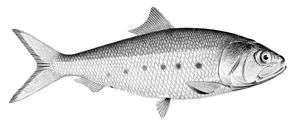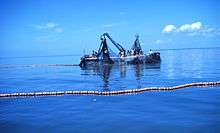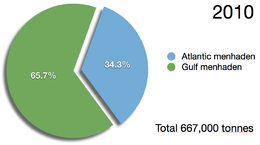Menhaden



Menhaden, also known as mossbunker, and bunker, are forage fish of the genera Brevoortia and Ethmidium, two genera of marine fish in the family Clupeidae. Menhaden is a blend of poghaden (pogy for short) and an Algonquian word akin to Narragansett munnawhatteaûg, derived from munnohquohteau ‘he fertilizes’, referring to their use of the fish use as fertilizer.[1] It is generally thought that Pilgrims were advised by Tisquantum (also known as Squanto) to plant menhaden with their crops.[1]
Description
Menhaden are flat, have soft flesh, and a deeply forked tail. They rarely exceed 15 inches (38 cm) in length, and have a varied weight range. Gulf menhaden and Atlantic menhaden are small oily-fleshed fish, bright silver, and characterized by a series of smaller spots behind the main, Humeral spot. They tend to have larger scales than Yellowfin menhaden and Finescale menhaden. In addition, Yellowfin menhaden tail rays are a bright yellow in contrast to those of the Atlantic menhaden.
Taxonomy
| This article is one of a series on |
| Commercial fish |
|---|
| |
| Large pelagic |
| billfish, bonito mackerel, salmon shark, tuna |
|
|
| Forage |
| anchovy, herring menhaden, sardine shad, sprat |
|
|
| Demersal |
| cod, eel, flatfish pollock, ray |
| Mixed |
| carp, tilapia |
Recent taxonomic work using DNA comparisons have organized the North American menhadens into large-scaled (Gulf and Atlantic menhaden) and small-scaled (Finescale and Yellowfin menhaden) designations.[2]
The menhaden consist of two genera and seven species:
- Genus Brevoortia T. N. Gill, 1861
- Brevoortia aurea (Spix & Agassiz, 1829) (Brazilian menhaden)
- Brevoortia gunteri Hildebrand, 1948 (Finescale menhaden)
- Brevoortia patronus Goode, 1878 (Gulf menhaden)
- Brevoortia pectinata (Jenyns, 1842) (Argentine menhaden)
- Brevoortia smithi Hildebrand, 1941 (Yellowfin menhaden)
- Brevoortia tyrannus (Latrobe, 1802) (Atlantic menhaden)
- Genus Ethmidium W. F. Thompson, 1916
- Ethmidium maculatum (Valenciennes, 1847) (Pacific menhaden)
Distribution
- Finescale menhaden range from the Yucatán to Louisiana
- Yellowfin menhaden range from Louisiana to Virginia
- Gulf menhaden range from the Yucatán Peninsula, Mexico to Tampa Bay, Florida
- Atlantic menhaden range from Jupiter Inlet, Florida, to Nova Scotia; Atlantic menhaden seasonally migrate along the coast; in June, mature adults typically are in the northern portion of the coastline with sub-adults and juveniles located in the southern portion
- The various species of menhaden occur anywhere from estuarine waters outward to the continental shelf; menhaden grow in less saline waters of estuaries and may be found in bays and lagoons, as well as at river mouths; adults appear to prefer water temperatures near 18 °C
Ecology
Menhaden travel in large, slow-moving, and tightly-packed schools with open mouths. Filter feeders typically take into their open mouths "materials in the same proportions as they occur in ambient waters".[3] Menhaden have two main sources of food: phytoplankton and zooplankton. A menhaden’s diet varies considerably over the course of its lifetime, and is directly related to its size. The smallest menhaden, typically those under one year old, eat primarily phytoplankton. After that age, adult menhaden gradually shift to a diet comprised almost exclusively of zooplankton.[4]
Menhaden are omnivorous filter feeders, feeding by straining plankton and algae from water. Along with oysters, which filter water on the sea bed, menhaden play a key role in the food chain in estuaries and bays.[5] Atlantic menhaden are an important link between plankton and upper level predators. Because of their filter feeding abilities, "menhaden consume and redistribute a significant amount of energy within and between Chesapeake Bay and other estuaries, and the coastal ocean."[6] Because they play this role, and their abundance, menhaden are an invaluable prey species for many predatory fish, such as striped bass, bluefish, mackerel, flounder, tuna, Drum (fish), and sharks. They are also a very important food source for many birds, including egrets, ospreys, seagulls, northern gannets, pelicans, and herons.

In 2012 the Atlantic States Marine Fisheries Commission declared that the Atlantic menhaden was depleted due to overfishing. The decision was driven by issues with water quality in the Chesapeake Bay and failing efforts to re-introduce predator species, due to lack of menhaden on which they could feed.[1]
Human intake
Menhaden are not used directly for food. They are processed into fish oil and fish meal that are used as food ingredients, animal feed, and dietary supplements.[5] It has a high in omega-3 fat content. Fish oil made from menhaden also is used as a raw material for products such as lipstick.[7]
Fisheries


According to James Kirkley of the Virginia Institute of Marine Science (VIMS), there are two established commercial fisheries for menhaden. The first is known as a reduction fishery. The second is known as a bait fishery, which harvests menhaden for the use of both commercial and recreational fishermen. Commercial fishermen, especially crabbers in the Chesapeake Bay area, use menhaden to bait their traps or hooks. The recreational fisherman use ground menhaden chum as a fish attractant, and whole fish as bait. The total harvest is approximately 500 million fish per year.[7] Atlantic menhaden are harvested using purse seines.
Omega Protein Inc., Houston, Texas, with operations in Virginia, Louisiana, and Mississippi takes 90% of the national total menhaden harvest.[7] In December 2012, in the face of the depletion of Atlantic menhaden, the Atlantic States Marine Fisheries Commission imposed a limit on Omega's operations, "capping the total annual commercial catch at 170,800 metric tons, about 80 percent of the average harvest from the last three years."[9]
Notes
- 1 2 3 Richard Conniff. "The Oiliest Catch". Conservation Magazine. Retrieved 2013-01-18.
- ↑ Anderson, Joel (2007). "Systematics of the North American menhadens: molecular evolutionary reconstructions in the genus Brevoortia (Clupeiformes: Clupeidae)" (PDF). Fishery Bulletin 105 (3): 368–378. Retrieved 10 February 2011.
- ↑ Gulf States Marine Fisheries Commission 2002
- ↑ Friedland, Kevin; Gobler, Christopher; Lynch, Patrick, "Time Series Mesoscale Response of Atlantic Menhaden Brevoortia tyrannus to Variation in Plankton Abundances," Journal of Coastal Research, 11 February 2011
- 1 2 Tom Tavee and H. Bruce Franklin for Discover Magazine. 1 September 2001. The Most Important Fish in the Sea
- ↑ "Maryland Department of Natural Resources". Dnr.state.md.us. 2012-12-31. Retrieved 2013-01-07.
- 1 2 3 Greenberg, Paul (15 December 2009). "A Fish Oil Story". The New York Times. Retrieved 10 February 2011.
archive via Archive.org not available due to login requirement; login not required to view content via provided link. - 1 2 Based on data sourced from the relevant FAO Species Fact Sheets
- ↑ Alison Fairbrother for The Bay Journal. 31 March 2013 Omega Protein makes good on threat to cut jobs; but it doesn’t have to
References
- "Brevoortia". Integrated Taxonomic Information System. Retrieved 6 June 2006.
- Pauly, Daniel (2007-11-02). "Fisheries: Tales of a small, but crucial, fish". Science 318 (5851): 750–751. doi:10.1126/science.1147800.
- (n.d.). Retrieved 20 April 2008, from Menhaden Matter: http://www.menhadenmatter.org/links.html
- Atlantic Menhaden Harvest. (n.d.). Retrieved 20 April 2008, from Chesapeake Bay Program: http://www.chesapeakebay.net/atlanticmenhadenmanagement.aspx?menuitem=15378
- Fote, T. P. (1997, May). Interactions of Striped Bass, Bluefish and Forage Species. Jersey Coast Anglers Association .
- Geartype Fact Sheets: Purse Seines . (n.d.). Retrieved 20 April 2008, from Food and Agricultural Organization of the United Nations: http://www.fao.org/fishery/geartype/249
- Kirkley, J. E. (2006). The Economic Importance and Value of Menhaden in the Chesapeake Bay Region. Gloucester Point, VA.
- Management: Conflict and Competition. (n.d.). Retrieved 20 April 2008, from Menhaden Resource Council: http://www.menhaden.org/management_conflict.htm
- Maryland Fish Facts: Atlantic Menhaden. (2007, 5 April). Retrieved 20 April 2008, from Maryland Department of Natural Resources: http://www.dnr.state.md.us/fisheries/fishfacts/menhaden.asp
- Mycobacteriosis: Frequently Asked Questions. (n.d.). Retrieved 20 April 2008, from Virginia Institute of Marine Science: http://www.vims.edu/myco/FAQ.html
- Plankton. (n.d.). Retrieved 20 April 2008, from Enchanted Learning: http://www.enchantedlearning.com/subjects/invertebrates/plankton/Planktonprintout.shtml
- Save the Stripers: Menhaden Update. (n.d.). Retrieved 20 April 2008, from National Coalition for Marine Conservation: http://www.savethefish.org/action_items_striped_bass_EAN8.htm
- Southwick Associates, Inc. (2006). Menhaden Math The Economic Impact of Atlantic Menhaden on Virginia’s Recreationa land Commercial Fisheries. Retrieved 20 April 2008, from National Coalition for Marine Conservation: http://www.savethefish.org/PDF_files/Menhaden_Math_report.pdf
- Virginia Institute of Marine Science (2009). Several menhaden research projects, currently unpublished.
- Durbin, A. G. and E. G. Durbin. 1998. Effects of Menhaden Predation on Plankton Populations in Narragansett Bay, Rhode Island Author. . Estuaries, Vol. 21, No. 3, (Sep., 1998), pp. 449–465.
- Smith, N. G. and C. M. Jones. 2007; What is the cause of menhaden recruitment failure? Quantifying the role of striped bass. Final Rept. Virg. Mar. Resou. Comm. Project #RF 05-01.
- Lynch, P. D. 2007. Feeding ecology of the Atlantic menhaden (Brevoortia tyrannus) in Chesapeake Bay. Master’s Thesis. The College of William and Mary, Virginia Institute of Marine Science. Gloucester Point, Virginia.
- Friedland KD, Ahrenholz DW, Smith JW, Manning M, Ryan J. 2006. Sieving functional morphology of the gill raker feeding apparatus of Atlantic menhaden. J. Exp. Zool. 305A:974–985.
- Saving Striped Bass by Managing Menhaden | KeepAmericaFishing™
- ASMFC. 2006. 2006 Stock Assessment Report for Atlantic Menhaden. Atlantic States Marine Fisheries Commission
External links
- NOAA Fisheries | NMFS
- Atlantic States Marine Fisheries Commission | ASMFC
- Gulf States Marine Fisheries Commission| GSMFC
| ||||||||||||||||||||||||||||
| |||||||||||||||||||||||||||||||||||||||||||||||


.png)
